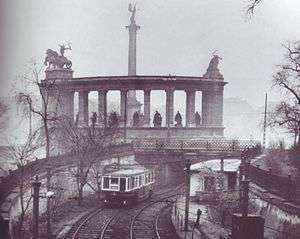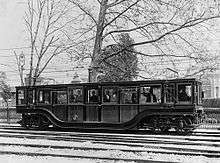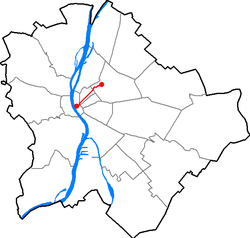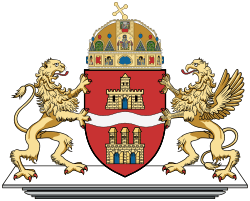Metro Line M1 (Budapest Metro)
| Metro Line M1 | |||
|---|---|---|---|
 | |||
 | |||
| Overview | |||
| Type | Rapid transit | ||
| System | Budapest Metro | ||
| Status | Operational | ||
| Termini |
Vörösmarty tér Mexikói út | ||
| Stations | 11 | ||
| Line number | Line 1 ("Yellow metro") | ||
| Operation | |||
| Opened | May 2, 1896 | ||
| Operator(s) | BKV | ||
| Technical | |||
| Line length | 4.4 km | ||
| Track gauge | 1,435 mm (4 ft 8 1⁄2 in) | ||
| Electrification | 550 V DC | ||
| Operating speed | 60 km/h | ||
| |||
Line 1 (Officially: Millennium Underground Railway, Metro 1 or M1) is the oldest line of the Budapest Metro. It is known locally as "the underground" ("a földalatti"), while the M2, M3 and M4 are called "metró". It is the third oldest underground after the London Underground and the Mersey Railway (specifically, its Wirral Line), the third rapid transit rail line worldwide of any type to exclusively use electric traction (after the London Underground, specifically the City and South London Railway and the strictly-above ground Liverpool Overhead Railway, before its closure in 1956), and the first on the European mainland. It was built from 1894 to 1896.
Line 1 runs northeast from the city center on the Pest side under Andrássy út to the Városliget, or City Park. Like Line 3, it does not serve Buda.
History
Line 1 is the oldest of the metro lines in Budapest, having been in constant operation since 1896.
The original purpose of the first metro line was to facilitate transport to the Budapest City Park along the elegant Andrássy Avenue without building surface transport affecting the streetscape. The National Assembly accepted the metro plan in 1870 and German firm Siemens & Halske AG was commissioned for the construction, starting in 1894. It took 2,000 workers using up-to-date machinery less than two years to complete. This section was built entirely from the surface (with the cut-and-cover method). Completed by the deadline, it was inaugurated on May 2, 1896, the year of the millennium (the thousandth anniversary of the arrival of the Magyars), by emperor Franz Joseph. One original car is preserved at the Seashore Trolley Museum in Kennebunkport, Maine, United States.
The line ran underneath Andrássy Avenue, from Vörösmarty Square (the centre) to City Park, in a northeast-southwest direction. The original terminus was the Zoo (with extension to Mexikói út in 1973). It had eleven stations, nine underground and two (Állatkert and Artézi fürdő) overground. The length of the line was 3.7 km at that time; trains ran every two minutes. It was able to carry as many as 35,000 people a day (today 103,000 people travel on it on a workday).
- 1896: Gizella tér (today Vörösmarty tér) - Artézi fürdő (today Széchenyi fürdő)
- 1973: Széchenyi fürdő - Mexikói út
Stations and connections
| Travel Time minutes |
Station | Travel Time minutes |
Connection | Buildings / Monuments |
|---|---|---|---|---|
| 0 | Vörösmarty tér | 11 | Vigadó, Café Gerbeaud, Ministry of Finance | |
| 1 | Deák Ferenc tér | 10 | Town Hall, Metro Museum (Földalatti Vasúti Múzeum) | |
| 2 | Bajcsy–Zsilinszky út | 9 | St. Stephen's Basilica | |
| 3 | Opera | 8 | Hungarian State Opera House | |
| 4 | Oktogon | 7 | Theaters (Operette, Mikroszkóp, Miklós Radnóti,...) | |
| 5 | Vörösmarty utca | 6 | House of Terror | |
| 6 | Kodály körönd | 5 | ||
| 7 | Bajza utca | 4 | ||
| 8 | Hősök tere | 3 | Museum of Fine Arts, Műcsarnok (Hall of Exhibitions), Városliget (City Park), Hősök tere (Heroes square) | |
| 9 | Széchenyi fürdő | 2 | Széchenyi thermal bath, Zoo and Botanical Garden | |
| 11 | Mexikói út | 0 | ||
Gallery
 Andrássy Avenue with the Millennium Underground (1896)
Andrássy Avenue with the Millennium Underground (1896)- Completing the cut-and-cover construction
 A train near the Hősök tere (before 1973)
A train near the Hősök tere (before 1973) Original rolling stock
Original rolling stock
 Train at Vörösmarty square
Train at Vörösmarty square- Station entry at Bajcsy-Zsilinszky út
 Preserved historic rolling stock in museum
Preserved historic rolling stock in museum- Line under construction at Oktogon
See also
- Tremont Street Subway, Boston's first underground railway tunnel and the first one built after Budapest's Line 1.
References
| Wikimedia Commons has media related to Budapest Metro line 1. |


